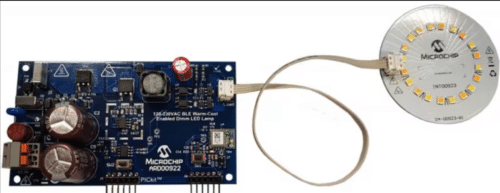The design integrates microcontroller technology with Bluetooth connectivity for efficient and customizable LED control.

Bluetooth LED White and Color Mix LEDs are modern lighting systems that combine energy efficiency with user control and customization. These lighting solutions allow users to adjust brightness, colour temperature, and hues directly from smartphones or other Bluetooth-enabled devices, providing convenience and versatility. Suitable for residential and commercial environments, these LEDs can transform and adapt spaces to suit various moods and activities and integrate into broader smart home systems. They also offer the potential for energy savings and improved accessibility, making them a practical choice for sustainable and inclusive lighting. The reference design from Microchip effectively integrates a buck LED driver (HV9961) with a PIC16F15313 8-bit Microcontroller.
Communication between the microcontroller and the BLE module (RN4871) is achieved through UART, facilitating an intelligent LED lighting solution. The power supply for the microcontroller and the BLE module is sourced directly from the grid at 120/230Vac using a bridge rectifier and a DN2470 depletion Field-Effect Transistor. This setup is stabilised by a 3.3V Low-Dropout (LDO) Regulator MCP1703, enabling the system to handle a broad input range from 50 Vac to 265 Vac.
The design also features a passive Power Factor Correction (PFC) mechanism that maintains a PFC of at least 0.9 at 120Vac and 0.85 at 230Vac. The buck LED driver employed in the demo operates using average current mode control in a constant off-time mode. This configuration eliminates peak-to-average error, enhancing the LED current’s accuracy, line, and load regulation without requiring loop compensation or high-side current sensing. The LED output current maintains an accuracy of ±3%.
In the realm of Bluetooth connectivity, the demo incorporates the BLE module. This module combines a Bluetooth 4.2 baseband controller, an onboard Bluetooth stack, digital and analogue I/O, and an RF power amplifier into a singular, low-energy solution. The BLE module features a proprietary GATT service, “Transparent UART, ” which facilitates straightforward serial data transfer over Bluetooth Low Energy devices, allowing seamless bidirectional data flow between the microcontroller and a smartphone.
The microcontroller processes data received from the Bluetooth module, controlling the LED’s colour temperature and intensity based on user inputs via a mobile application. It also stores the last set of values in its flash memory, which are then used as default on the next power-up.
For the LED configuration, the design uses 20 LEDs arranged into two interlaced strings of 10 LEDs each, each offering a different white colour temperature (warm/cool). This LED load is designed to operate at 30 V / 275 mA. The mobile application enhances user interaction with the design, offering sliders to adjust the brightness and colour temperature of the LEDs and buttons for toggling the light on/off and activating a demonstration feature.
Microchip has tested this reference design. It comes with a bill of materials (BOM), schematics, assembly drawing, printed circuit board (PCB) layout, and more. The company’s website has additional data about the reference design. To read more about this reference design, click here.









